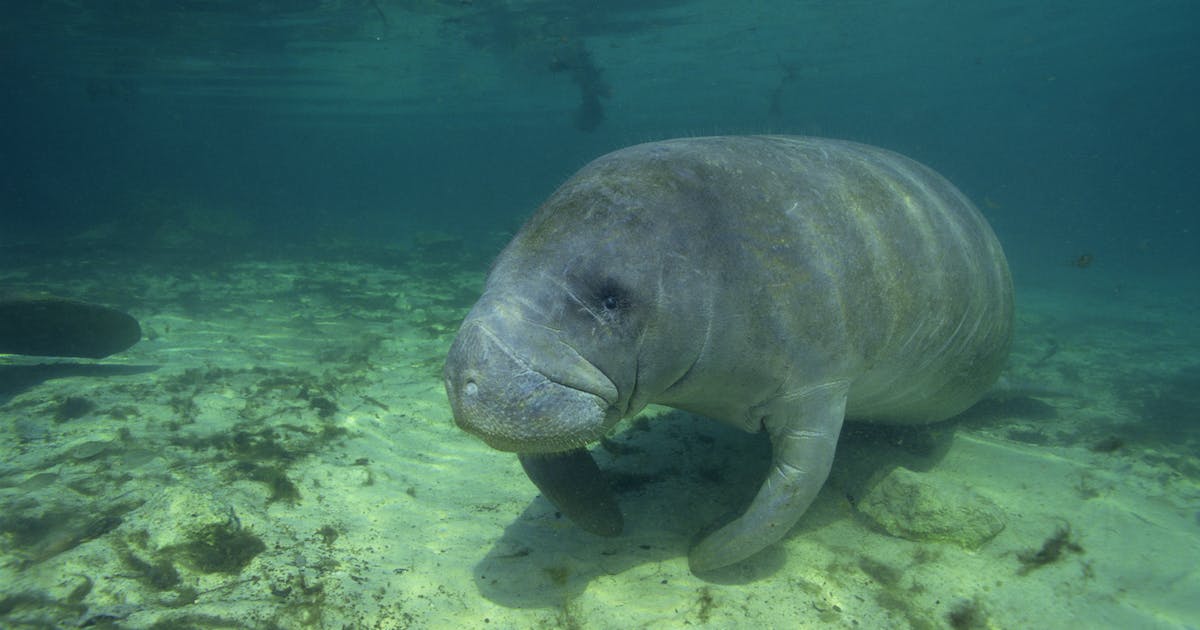Wildlife officials will begin feeding starving Florida manatees in the midst of a staggering die-off.
The story: It’s been a tough year for Florida manatees. More than 1,000 of the charismatic marine mammals known as “sea cows” died in 2021, making it the deadliest year on record. The cause: pollution and unprecedented algal blooms that have destroyed the seagrass ecosystems manatees depend on for food — particularly in Indian River Lagoon, a 156-mile estuary that manatees use to keep warm during winter months.
Catrin Einhorn reports for the New York Times that federal and state wildlife officials are now rushing to save the threatened Florida manatee through an experimental feeding program, which will provide cabbage and other leafy greens to the starving animals. The move is unprecedented and comes with the inherent risks. Collisions with watercrafts are one of the leading causes of death for manatees, and the feeding program has the potential to further habituate them to boats.
The big picture: The difficult and urgent situation facing Florida’s most iconic marine mammal offers further proof that humans continue to drastically alter the habitats wildlife depend on. “The manatee situation is a symptom,” Duane De Freese, a marine biologist, told the New York Times, describing the current algal blooms as a “tipping point.”
And as climate change brings more severe storms and sea level rise, the environmental issues facing the region are only expected to worsen, exacerbating problems for manatees and other marine life. While feeding these gentle, aquatic giants may offer a short-term fix, lasting solutions are needed to address the severe environmental degradation.
Good news for tropical forests (yes — you read that right).
The story: According to a new study, tropical forests felled by deforestation can bounce back more quickly than scientists previously thought, reports Tik Root for the Washington Post. Scientists currently estimate that 5.5 million hectares (13.5 million acres) of tropical forest — an area more than twice the size of Vermont — is cut down every single year. In a landmark study, nearly 100 authors evaluated data from three continents to find out how quickly these landscapes could rebound.
The answer was surprising: Without human intervention, soil on deforested lands can often recover its fertility in less than a decade and the full, overall biomass of a forest has the potential to return within a century. While this may seem like a long time to us humans — longer than most of us will live — it’s a mere blip on the evolutionary scale of the planet.
The big picture: While there is no equal to old growth forests — which are responsible for storing incredible amounts of climate-altering carbon — establishing younger, second-growth forests in deforested areas is a hugely important part of avoiding the worst climate impacts. Around the world, nearly a billion hectares of degraded land has the potential to be restored right now — without impacting the food security of local communities.
Last year a team of researchers, including Conservation International climate expert Bronson Griscom, set out to discover what would happen if we let deforested lands return back to forests. The result was a global map that pinpoints forest areas with most potential to help humanity combat climate change —as long as we leave them alone. With this information, countries can now identify where forest restoration efforts will provide the highest returns on investment, ensuring long-term carbon capture.
A doomsday monolith is being built to chronicle the climate crisis.
The story: A group of climate activists in Australia are creating what they call Earth’s “black box”— a colossal structure designed to tell the story of the climate crisis to future civilizations, reports Rachel Ramirez for CNN. The stark and brutalist device, which calls to mind any number of imposing science fiction monoliths, will “record every step we take toward this catastrophe,” its designers write. Within its steel walls, hundreds of data sets and climate-related conversations will be stored, comprising a “ledger on the health of our planet.”
“We hope it will hold leaders to account and inspire action and reaction in the broader population,” Jonathan Kneebone, an artist involved with the project told CNN.
The big picture: While there’s certainly something intriguing about imagining a far-flung, distant society uncovering and internalizing the stories from our climate past — we’re not quite there, yet. There is still hope, and still time to change our climate trajectory.
“We must act now,” says Conservation International scientists Will Turner. “We must dramatically and immediately decarbonize our energy and industry sectors. We must also protect, restore and better manage the planet’s ecosystems. And we need to pursue new technologies that could help remove carbon that’s already in the atmosphere.”
By investing in real, tangible solutions that value and protect nature, we can still stabilize our climate — and negate the need to build a mausoleum dedicated to our failure.

